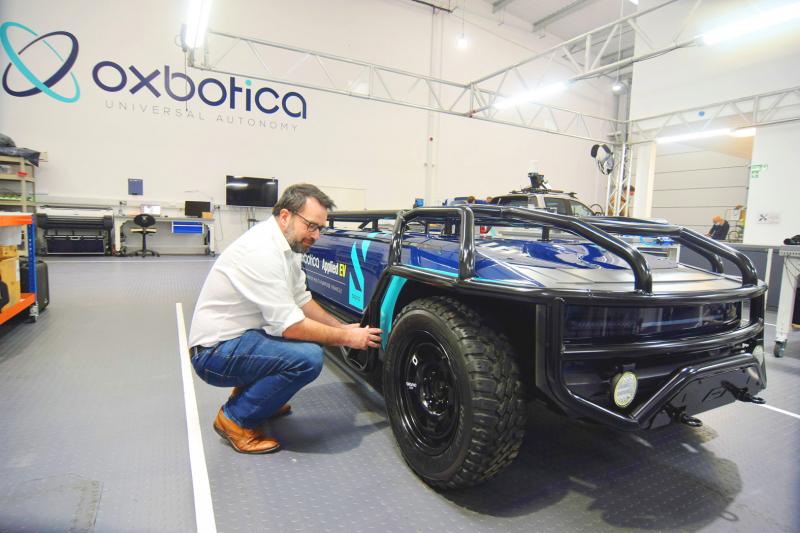We would all be whizzing round in robotaxis by now if Elon Musk had been right.
Instead, fully self-driving vehicles are struggling to get away from the starting grid and some investors are betting that driverless trucks would reach the chequered flag first.
Only a year ago, start-ups developing robotaxis were pulling in eight times more funding than firms working on autonomous trucks, buses and logistics vehicles, but the gap has narrowed dramatically this year.

Photo: Reuters
With fewer regulatory and technological hurdles, trucks operating on major highways, fixed delivery routes or in environments far from cyclists and pedestrians, such as mines and ports, are now being seen as a faster way to generate returns.
In the year through Monday, total investment activity for self-driving logistics vehicles leapt fivefold to US$6.5 billion from US$1.3 billion in the same period last year, according to start-up data platform PitchBook.
Meanwhile, investment activity for robotaxi firms fell 22 percent to US$8.4 billion from US$10.8 billion over the same period, the PitchBook data compiled for Reuters shows.
The numbers might even understate the trend as some robotaxi firms, such as Alphabet Inc’s Waymo, are pumping more cash into their own autonomous trucking operations as well.
In the latest trucking deal, Robotic Research said on Thursday that it has raised US$228 million by tapping outside investors for the first time to expand its autonomous trucks, buses and logistics vehicles business.
The new money comes from investors including Softbank Group Corp’s Vision Fund 2, Enlightenment Capital and Luminar Technologies, which makes lidar sensors used in self-driving vehicles.
Robotic Research chief executive alberto Lacaze told reporters that the company was deploying autonomous vehicles at scale where the business case works for customers “right now.”
“They don’t have to wait until 2025, unlike robotaxis where you need to have the cost of all the sensors come down by an order of magnitude,” he said.
OVERPROMISES
As recently as 2019, Tesla Inc’s Musk had promised 1 million robotaxis “next year for sure,” but self-driving vehicles that can navigate safely anywhere are still a long way off.
Peter Rawlinson, head of electric vehicle (EV) start-up Lucid Motors Inc, last month said it would be a decade before fleets of robotaxis hit the roads — even with the most advanced sensors.
PitchBook’s lead mobility analyst Asad Hussain said start-ups such as Gatik, which makes autonomous short-haul vans, and Nuro with its mini delivery robots, could eclipse Waymo and rival Cruise over the next few years in commercializing at scale.
Still, while long-haul trucks are easier to automate than robotaxis because major highways are simpler environments than bustling city roads, self-driving truck company executives are cautious about how fast they can ramp up.
“We’re very cognizant of the overpromises that the industry has made,” said Lu Cheng (呂程), chief executive of self-driving truck technology company TuSimple Holdings Inc, which went public in the US in April with a market value of US$8.5 billion.
“The industry understands the complexity of the problem now and that solving it will take a longer time,” he said.
For now, TuSimple has a fleet of about 50 trucks with safety drivers aboard crisscrossing the US’ warmer southern states, but it plans to have a national network covering major US highways by 2024.
That would involve major investments in mapping highways, learning how to handle tougher weather and road conditions further north and in new self-driving trucks being developed by Navistar International Corp, which is part of Volkswagen AG’s Traton.
‘A LONG JOURNEY’
However, rolling out a truly national network could take years as self-driving trucks still face a major challenge: human drivers.
An autonomous vehicle would always hit the brakes if it encounters a “testosterone-laden human male,” said Ralf Klaedtke, chief technology officer at TE Connectivity, which makes sensors and electronic systems to handle masses of self-driving data for the auto industry.
“The autonomous vehicle will always be the slowest in mixed traffic,” he said.
Paul Newman, founder of British autonomous vehicle software start-up Oxbotica, said robotaxis remained his “North Star,” his clear long-term goal.
However, for now he is focusing on simpler applications, some of which use a purpose-built, fully electric self-driving vehicle from Australian start-up Applied EV.
“This is a long journey,” he said while showing off test vehicles at the company’s headquarters in Oxford, England. “It’s one of the hardest engineering problems to solve.”
Oxbotica is working on vehicles for mines in partnership with Wenco, part of Hitachi Construction Machinery Co, and on many different options with energy company BP PLC, such as vehicles for remote wind and solar farms.
Morag Watson, BP’s senior vice president for digital science and engineering, said Oxbotica’s technology could monitor large sites, or haul equipment out to humans undertaking repairs.
She said they would be testing many different options next year.
“We’ve barely scratched the surface of what we can do with industrial autonomy,” Watson said.
Oxbotica is also working with British online food delivery and technology company Ocado Group PLC, which automates supply chain systems for the likes of US retail chain Kroger Co. BP and Ocado have both invested in Oxbotica.
Alex Harvey, Ocado’s head of advanced technology, said Oxbotica’s technology could be used “in the warehouse, in the yard, on the road, or kerb to kitchen.”
NO LEFT TURNS
US autonomous EV maker Outrider has targeted distribution yards — picking up trailers after truckers drop them off and lining up new ones to be hauled away — including at a Chicago yard for paper company Georgia-Pacific LLC.
Outrider has developed a robot arm for the truck to connect and disconnect trailers. It has raised US$118 million so far and chief executive Andrew Smith says it would scale up to thousands of vehicles over the next five years.
The start-up wants to start doing short hops between yards, but operating on public roads adds complexity, Smith said.
“We saw through the early hype of the technology and recognized distribution yards were the perfect near-term solution with their repetitive, low-speed operations in confined environments,” he said.
Going out on public roads requires moving carefully, partly because of regulations, but also because of legal pitfalls in a litigious market such as the US.
Ian White, chief executive of digital insurer Koffie Labs Inc, said a “black-swan billion-dollar” crash could wipe out any company that moves too fast and gets it wrong.
“You’d be putting your balance sheet on the line,” he said.
That is why Gatik has opted for a careful approach for its “middle-mile” delivery routes between distribution centers and retailers, chief executive Gautam Narang said.
Gatik’s trucks run on short, predictable routes avoiding left turns across oncoming traffic, schools, hospitals, fire stations, blind turns — or anything complicated.
“We’re not working on every tricky situation the autonomous vehicle industry is trying to solve,” he said. “We’re taking baby steps using routes that are uneventful from a complexity standpoint.”
Gatik works with Walmart Inc and Loblaw Companies Ltd using autonomous trucks with safety drivers, although it operates some driverless routes in Arkansas and sees the global shortage of drivers as an opportunity.
“We decided to focus on a simpler use case where the need was very acute,” Narang said. “We’re not building the technology for technology’s sake.”

The US dollar was trading at NT$29.7 at 10am today on the Taipei Foreign Exchange, as the New Taiwan dollar gained NT$1.364 from the previous close last week. The NT dollar continued to rise today, after surging 3.07 percent on Friday. After opening at NT$30.91, the NT dollar gained more than NT$1 in just 15 minutes, briefly passing the NT$30 mark. Before the US Department of the Treasury's semi-annual currency report came out, expectations that the NT dollar would keep rising were already building. The NT dollar on Friday closed at NT$31.064, up by NT$0.953 — a 3.07 percent single-day gain. Today,

‘SHORT TERM’: The local currency would likely remain strong in the near term, driven by anticipated US trade pressure, capital inflows and expectations of a US Fed rate cut The US dollar is expected to fall below NT$30 in the near term, as traders anticipate increased pressure from Washington for Taiwan to allow the New Taiwan dollar to appreciate, Cathay United Bank (國泰世華銀行) chief economist Lin Chi-chao (林啟超) said. Following a sharp drop in the greenback against the NT dollar on Friday, Lin told the Central News Agency that the local currency is likely to remain strong in the short term, driven in part by market psychology surrounding anticipated US policy pressure. On Friday, the US dollar fell NT$0.953, or 3.07 percent, closing at NT$31.064 — its lowest level since Jan.

The New Taiwan dollar and Taiwanese stocks surged on signs that trade tensions between the world’s top two economies might start easing and as US tech earnings boosted the outlook of the nation’s semiconductor exports. The NT dollar strengthened as much as 3.8 percent versus the US dollar to 30.815, the biggest intraday gain since January 2011, closing at NT$31.064. The benchmark TAIEX jumped 2.73 percent to outperform the region’s equity gauges. Outlook for global trade improved after China said it is assessing possible trade talks with the US, providing a boost for the nation’s currency and shares. As the NT dollar

The Financial Supervisory Commission (FSC) yesterday met with some of the nation’s largest insurance companies as a skyrocketing New Taiwan dollar piles pressure on their hundreds of billions of dollars in US bond investments. The commission has asked some life insurance firms, among the biggest Asian holders of US debt, to discuss how the rapidly strengthening NT dollar has impacted their operations, people familiar with the matter said. The meeting took place as the NT dollar jumped as much as 5 percent yesterday, its biggest intraday gain in more than three decades. The local currency surged as exporters rushed to